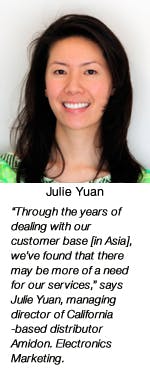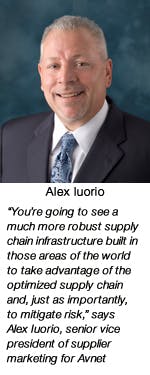American manufacturers and distributors are still betting on Asia to remain the world’s leading low-cost manufacturing center despite slowing growth in the region and industry talk about the “re-shoring” of projects back to North America. Supply chain companies continue to invest in Asia, seeking new opportunities and expanding existing operations—particularly in China, which analysts predict will continue to see the lion’s share of the region’s manufacturing activity.
Electronics distributors are making the most of these opportunities with enhanced services, new locations to better serve customers in the region, and a focus on developing more nimble global supply chains. Market leaders say that focus is especially crucial as manufacturers place increasing importance on the “design anywhere, build anywhere” philosophy, which benefits those suppliers that can serve them in multiple locations around the world. Still, whether they have served customers globally for years or are just starting to build an international presence, distributors selling in Asia are observing five key trends that are shaping the local business landscape.
1. Slowing but still growing
Distributors doing business in Asia say growth is slowing, but they still point to the region as a good long-term source of business for those supplying the range of manufacturing operations there, especially contract manufacturers. IHS senior analyst Jeffrey Wu concurs, pointing to a slowdown across the entire outsourced manufacturing business in Asia since the 2008-2009 recession.
“What we see happening in Asia is [that] growth has slowed down compared to five years ago,” says Wu. “Then, [you had] 5% compound annual growth. Now, between 2012 and 2017, the compound annual growth rate really is somewhere in the 1.5% to 2% ballpark depending on the region.”
Wu points to rising labor rates, government efforts to update infrastructure, the expiration of certain tax benefits, and efforts to impose stricter environmental regulations as some reasons for the slower growth. But he adds that those conditions are not enough to keep Asia, and especially China, from maintaining its status as the world’s leading low-cost manufacturing center.
“Does this mean that China won’t be the world’s factory anymore?” Wu says clients often ask. “Our answer is no.”
Steve Martin, president of U.S.-based distributor Components Direct, agrees. Components Direct specializes in managing manufacturers’ excess and obsolete components and does more than 50% of its business with customers in Asia. It has a warehouse in Hong Kong, with sales and service handled online through its e-commerce business.
“I think Asia is going to be a growing market,” Martin says. “The facts and figures are that it’s down and becoming more competitive, but I think that for a lot of companies—especially for a lot of North American companies—there’s a lot of potential in the Asia market.”
2. China maintains its lead
“It’s really about design anywhere and build anywhere, [and the trend] happens to be Asia today,” says Alex Iuorio, senior vice president of supplier marketing for Avnet Electronics Marketing. Iuorio emphasizes the region’s importance by pointing to the migration of manufacturing work within Asia, specifically the movement away from coastal regions to inland China and some movement to other countries such as Malaysia and Vietnam.
“[It’s about] what makes the most sense for a particular customer,” Iuorio explains, noting that other trends such as regionalized manufacturing—in which companies build products closer to where they will be consumed—and local market demand are additionally coming into play.
IHS’s Wu agrees, emphasizing domestic demand as a key to the region’s ongoing strength.
“[In the last five years], products being built in China are being driven by an ever-increasing demand in the domestic market,” he explains. “Ten years ago, the majority of product output was used for export. We don’t have exact figures, but we’re seeing that Chinese market demand is driving production in China to a much more significant degree than it did five to 10 years ago.”
Julie Yuan, managing director of California-based specialty distributor Amidon, agrees that China will remain the region’s top low-cost manufacturing center for some time. Although she says there are projects that are going to Vietnam and Thailand, she notes that there has not been a mass exodus of work to other countries.
“It’s not enough to disrupt the flow of contract manufacturing to China,” she says, adding that she also sees a growing contract manufacturing base that does specialized work due to better, more consistent quality in the region. Amidon supports customers in government, medical, consumer electronics, and similar industries and is expanding its business in Southern China by opening an office in Hong Kong this fall.
3. Migration to inland China
“You get there because of the low-cost workforce, and now you have an inherent problem—roads, transportation [and so forth],” says Iuorio. “That will drive infrastructure, which will in turn drive supply chain processes. It makes sense to me that the biggest changes [ahead] will be around supply chain services as it relates to global customers moving their manufacturing to Asia.”
Wu agrees, adding that the migration will result in new manufacturing clusters in China, which should also help drive growth.
“What’s happening now is… there are a few distinct clusters in China. [As] they move production inland, there are newer hubs,” Wu says, pointing to local supply chains that have developed in China over the last 15 to 20 years that make it difficult for manufacturers to move elsewhere, especially to higher-cost countries under the guise of “re-shoring.”
“We still believe that a shift to the U.S. is symbolic,” adds Wu, pointing to companies such as Apple and Motorola who have announced that they will build or assemble some products back on U.S. soil. “Despite program shifts back to the U.S., we do not see that kind of formation of manufacturing clusters or supply chain clusters all over again in the U.S.”
4. Optimized supply chains are a must
Avnet’s Iuorio points to supply chain optimization as a key issue, especially as it relates to the “design anywhere, build anywhere” strategy. He says much of the world’s design work is still done in the West, and as production moves East, the situation begs for an optimized supply chain—one in which manufacturers, distributors, and customers have the technology, logistics, and infrastructure in place to serve customers efficiently, anywhere in the world.
“You’re going to see a much more robust supply chain infrastructure built in those areas of the world to take advantage of the optimized supply chain and, just as importantly, to mitigate risk,” says Iuorio, pointing to Avnet’s 300 locations in 70 countries. “What we do is couple the design chain with our supply chain so customers can design anywhere and build anywhere.”
Hand in hand with that, manufacturers are paying closer attention to their “real and total” costs these days, which is affecting their decisions to manufacture some products in regions close to where they will be consumed.
“We’re seeing more of a discerning view of what the real and total costs are and what makes sense for an individual customer,” says Iuorio. “There is no question that we’re seeing many, many [companies] manufacture in the Asia-Pacific region closer to where they think end demand will be.”
5. Growing demand for specialty services
As customers move production to China, many distributors are moving to Asia. As Yuan explains, Amidon’s move to Hong Kong this fall is a result of careful research among existing customers in the region and management’s belief that there is a growing need for the specialized services Amidon provides. Amidon is a specialty distributor of ferrites, iron powder cores, and custom inductors/transformers focusing on small-quantities, typically working with purchase orders that range from $50 and up.
“We think there are more people out there that don’t have an outlet for these small quantity [buys],” says Yuan, noting her existing contract manufacturing customers as well as potential customers in the region who may be missing out on smart buying opportunities because they simply don’t have the staff or resources in the region to find them. Amidon can help not only by supporting smaller projects, but also by seeking opportunities that require a backup source of components.
“It’s something we’ve noticed over time,” says Yuan. “Through the years of dealing with our customer base there, we’ve found that there may be more of a need for our services.”
Yuan will travel to Hong Kong in September to work on building Amidon’s business. The company has office space and some staff in the region, mainly outside sales. Asia represents about 8% of Amidon’s overall sales now. The move to expand internationally is aimed at helping this small company grow in what continues to be a challenging economic environment.
“We have really been struggling with the idea of whether to bring on more lines or find other avenues of expansion,” she says. “This is one of many ideas we’re hoping to execute.”










